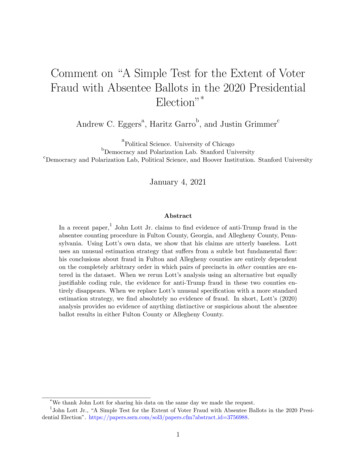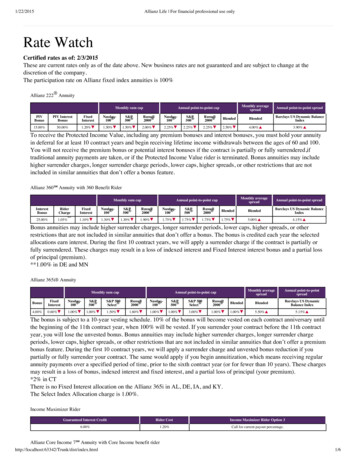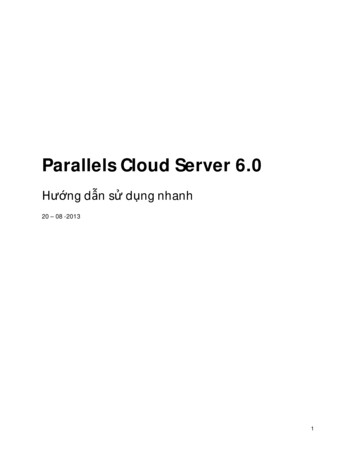
Transcription
Comment on “A Simple Test for the Extent of VoterFraud with Absentee Ballots in the 2020 Presidential Election”abcAndrew C. Eggers , Haritz Garro , and Justin GrimmeraPolitical Science. University of ChicagoDemocracy and Polarization Lab. Stanford UniversitycDemocracy and Polarization Lab, Political Science, and Hoover Institution. Stanford UniversitybJanuary 4, 2021Abstract1In a recent paper, John Lott Jr. claims to find evidence of anti-Trump fraud in theabsentee counting procedure in Fulton County, Georgia, and Allegheny County, Pennsylvania. Using Lott’s own data, we show that his claims are utterly baseless. Lottuses an unusual estimation strategy that suffers from a subtle but fundamental flaw:his conclusions about fraud in Fulton and Allegheny counties are entirely dependenton the completely arbitrary order in which pairs of precincts in other counties are entered in the dataset. When we rerun Lott’s analysis using an alternative but equallyjustifiable coding rule, the evidence for anti-Trump fraud in these two counties entirely disappears. When we replace Lott’s unusual specification with a more standardestimation strategy, we find absolutely no evidence of fraud. In short, Lott’s (2020)analysis provides no evidence of anything distinctive or suspicious about the absenteeballot results in either Fulton County or Allegheny County. We thank John Lott for sharing his data on the same day we made the request.John Lott Jr., “A Simple Test for the Extent of Voter Fraud with Absentee Ballots in the 2020 Presidential Election”. https://papers.ssrn.com/sol3/papers.cfm?abstract id 3756988.11
1IntroductionWe reexamine the evidence for voter fraud presented in “A Simple Test for the Extent ofVoter Fraud with Absentee Ballots in the 2020 Presidential Election” (hereafter Lott (2020)).Lott (2020) claims that a comparison of adjacent election precincts in Georgia and Pennsylvania supports the Trump campaign’s allegations that the 2020 presidential election was“stolen” through fraud. In Lott (2020)’s abstract, he estimates that fraud in Fulton Countycontributed 11,350 votes to Biden (over 80% of Joe Biden’s lead in Georgia) and fraud inAllegheny County contributed about 55,270 votes to Biden’s victory in Pennsylvania (around2/3 of Biden’s lead in Pennsylvania). If true, these claims would cast serious doubts on the2integrity of the 2020 election. The paper has already received wide attention.In this comment, we show that Lott’s claims are entirely baseless: his analysis producesabsolutely no evidence of fraud in either Fulton County or Allegheny County. Perhaps inrecognition of the high stakes surrounding claims of electoral fraud in the 2020 presidentialelection, Lott shared his data with us, making it possible to re-analyze his claims. Our reanalysis of the data shows that Lott’s evidence for fraud depends completely on an entirelyarbitrary decision about how counties are entered in the dataset: the conclusion is reversedwhen an alternative and equally justified data entry rule is used. When we replace Lott’sunusual specification with a more standard approach that does not depend on arbitrarycoding rules, we find absolutely no evidence for fraud in either Fulton County or AlleghenyCounty.In short, even if we accept Lott’s premise that differences in Trump’s share of the absentee vote between adjacent precincts can be used to detect fraud (which is itself debatable),and even if we use Lott’s own data to conduct this assessment, we find no evidence of fraudwhatsoever in the allegedly problematic counties.2Lott’s (2020) Results Depend Entirely on an Arbitrary Coding RuleLott (2020) seeks to estimate the effect of the absentee ballot counting procedure in countieswhere fraud has been alleged by Trump and other Republicans: Fulton County, GA, andAllegheny County, PA. Lott (2020)’s approach assumes that Trump’s share of the absenteevote in a precinct is related to Trump’s share of the in-person vote in the precinct and voterdemographics. Lott (2020) recognizes, however, that a difference in Trump’s share of the absentee vote across neighboring counties, even controlling for Trump’s share of the in-personvote and demographics, is not necessarily evidence of fraud. There may be other factors that2Peter Navarro, the outgoing Assistant to the President and Director of the Office of Trade and Manufacturing Policy, promoted the paper in a tweet on December 29 3659004928). The next day, Donald Trump also tweeted about the study 3684983017473).2
vary across counties that could produce such differences.To eliminate some of these alternative explanations for differences in Trump’s absentee support between “suspect” counties and neighboring counties, Lott (2020) focuses onprecincts that lie along county borders. Specifically, he forms pairs of precincts that liealong a boundary separating a suspect county (i.e. one where Republicans have alleged thatfraud took place) and an adjacent county where Trump won a majority of the vote and no3fraud allegations have been made. Lott (2020) also forms pairs of precincts that lie alongthe boundary between two of these Republican counties, which serve as a kind of controlgroup for the other pairs. Lott (2020) then conducts his analysis using within-pair differencesin each variable: he regresses the difference in Trump’s share of the absentee vote betweenthe two precincts on the difference in Trump’s share of the in-person vote between the two4precincts and an indicator for whether the pair contains a precinct in a suspect county.That is, his basic regression equation is(Absenteei Absenteej ) β0 β1 (InPersoni InPersonj ) δSuspectCountyi uij ,where Absenteei is Trump’s share of the absentee vote in precinct i, Personi is Trump’s shareof the in-person vote in precinct i, SuspectCountyi indicates whether precinct i is located ina “suspect” county, and i and j are adjacent precincts that Lott assigns to a pair. Thus β0measures the within-pair difference in Trump’s share of the absentee vote among pairs thatdon’t involve a suspect county (adjusting for the within-pair difference in Trump’s in-personshare), and the key coefficient is δ, which compares the adjusted difference in Trump’s shareof the absentee vote within pairs involving the suspect county against the corresponding adjusted difference within pairs not involving the suspect county. The underlying logic seemsto be that fraud is the likely explanation if there is a bigger drop in Trump’s share of theabsentee vote when we cross from, for example, Coweta County to Fulton County than whenwe cross from Coweta County to Carroll County, two Republican counties where no fraudhas been alleged.Even if we stipulate that focusing on adjacent precincts successfully addresses all rele5vant confounding variables, Lott (2020)’s design suffers from a fatal flaw. As noted, Lott(2020)’s design measures a difference in two differences: is the drop in Trump’s share of theabsentee vote larger when we cross the Fulton County border into Republican counties thanwhen we cross the border of one Republican county into another Republican county? Theproblem arises in measuring the second difference: there is no clear rule for determining theorder of the difference. For example, should we record the change in Trump’s absentee voteshare as we move from Carroll to Coweta, or as we move from Coweta to Carroll? Neither3By ruling out comparisons between precincts in “suspect” counties and surrounding Democratic-leaningcounties, Lott severely restricts his sample size and likely excludes the most similar comparisons.4In some specifications he also includes differences in various race-and-gender groups between the twoprecincts.5This is doubtful. For example, Trump won just 9.6% of the in-person vote in a precinct in FultonCounty (FA01B) that is adjacent to a precinct in Coweta County where Trump won 78% of the in-personvote (Fischer Road). It seems unlikely that precincts that differ so markedly in voting outcomes would besimilar in e.g. voters’ propensity to vote in person vs. absentee conditional on their vote choice.3
Figure 1: Evidence for fraud in Fulton County, GA, is reversed if arbitrary coding rule isreversedDifference in Trump's shareof absentee vote (within pair)Lott's coding:Non Fulton pairs indexedwest to east, south to northAlternative coding:Non Fulton pairs indexedeast to west, north to south0.0Pair typeFulton &non FultonBoth non Fulton 0.2Anti Trump biasPro Trump bias 0.4 0.50 0.250.00 0.50 0.250.00Difference in Trump's share of in person vote (within pair)county is “suspect”, so either approach could be justified. Lott (2020, footnote 13) choosesone rule (subtracting east from west and north from south) but the opposite rule or indeedany rule would be equally justified. This arbitrariness is a symptom of the underlying lackof compelling logic behind this aspect of the design: there is no clear reason to benchmarkthe difference in voting patterns across the key county boundary against the corresponding6difference across another boundary.As it turns out, Lott (2020)’s evidence for fraud in Fulton County, GA, and AlleghenyCounty, PA, relies entirely on this arbitrary coding rule: if a different but equally valid ruleis used we reach the opposite conclusion from Lott (2020). Figure 1 illustrates the point forFulton County. In both panels, each red dot corresponds to a pair of precincts lying on opposite sides of the Fulton County boundary; each blue dot corresponds to a pair of precinctslying on opposite sides of the boundary between two nearby Republican counties. The vertical axis shows the difference in Trump’s share of the absentee vote within the precinct pair;the horizontal axis shows the difference in Trump’s share of the in-person vote within theprecinct pair.The left panel of Figure 1 shows the analysis using Lott (2020)’s coding: for pairs in6One could imagine a better design that compared the magnitude (i.e. absolute value) of differences acrosssuspect boundaries and other boundaries. In this case the ordering of precinct pairs would not matter. Thisis not Lott’s design.4
cluding a Fulton County precinct, the Trump share for the non-Fulton County precinct issubtracted from the Trump share for the Fulton County precinct; for pairs not including aFulton County precinct, Lott (2020) uses the arbitrary rule noted above. This coding resultsin what Lott interprets as evidence for anti-Trump bias in Fulton County. Conditional on thedifference in Trump’s in-person vote share within a precinct pair, the difference in Trump’sabsentee vote share is lower in precinct pairs involving Fulton County than in other precinctpairs.In the right panel of Figure 1 we show that the conclusion is reversed when we reverseLott’s arbitrary coding rule: instead of subtracting east from west and north from south incomputing differences for non-Fulton precinct pairs, we subtract west from east and southfrom north. The scatterplot looks identical to the left panel except that the four blue dots(representing non-Fulton precinct pairs) are reflected through the origin. This small changereverses the conclusion, however: by Lott (2020)’s logic we now have evidence of pro-Trumpbias in Fulton County.Table 3 (Appendix) reports coefficient estimates and standard errors for both sets ofanalysis depicted in Figure 1. The evidence of pro-Trump fraud with the alternative codingrule has a similar absolute t-statistic (t 1.67) as Lott’s evidence of anti-Trump fraud withthe original coding rule (t 1.89).The Pennsylvania results also depend on Lott’s arbitrary coding rule, as we show in thesame manner in Figure 2 and Table 4 (Appendix). Lott (2020) concludes from his analysis that anti-Trump fraud took place in Allegheny County, but if we apply a different butequally valid coding rule we find (by the same logic) stronger evidence for pro-Trump fraudin Allegheny County: the positive coefficient we obtain with the alternative coding rule isboth larger in magnitude and more significant than the negative coefficient Lott reports.We can further highlight the dependence of Lott’s results on arbitrary coding decisions byexploring the universe of possible fraud estimates that Lott could have reported with equallyjustified alternative coding rules. In Figure 3 we show that, among the possible rules thatcould be used, any alternative rule would have produced weaker apparent evidence for antiTrump fraud in Fulton County and almost any rule would have produced weaker evidence7for anti-Trump fraud in Allegheny County. In the Fulton County analysis, there are four4non-Fulton precinct pairs and thus 2 16 possible rules for computing differences withinnon-Fulton pairs. The left panel of Figure 3 shows the histogram of the key coefficient acrossthese sixteen possible rules, with a vertical line highlighting the estimate for the rule Lottused. Among the sixteen possible rules, Lott’s rule produces the strongest apparent evidenceof anti-Trump fraud; six possible rules produce apparent evidence of pro-Trump fraud. Inthe Pennsylvania analysis we have seventeen non-implicated precinct pairs, allowing for over130,000 possible coding rules. The right panel of Figure 3 shows the distribution of estimates7In personal communication Lott said the ordering of precincts followed a rule in a prior AER paper. Webelieve that is Bronars and Lott (1998).5
Figure 2: Evidence for fraud in Allegheny County, PA, is reversed if arbitrary coding rule isreversedLott's coding:Non Allegheny pairs indexedwest to east, south to northAlternative coding:Non Allegheny pairs indexedeast to west, north to southDifference in Trump's shareof absentee vote (within pair)0.20.1Pair typeAllegheny &non AlleghenyBoth non Allegheny0.0 0.1Anti Trump biasPro Trump bias 0.50 0.250.000.250.50 0.50 0.250.000.25Difference in Trump's share of in person vote (within pair)60.50
Figure 3: Evidence for fraud in Georgia and Pennsylvania depends on arbitrary coding rules;Lott’s estimates are outliers in the distribution of estimates8for a random sample (with replacement) of 100,000 of these rules, with the actual estimateagain shown with a vertical line. The distribution is centered around zero, with roughly asmany rules producing apparent evidence of pro-Trump and anti-Trump fraud; Lott’s ruleagain happens to produce among the strongest apparent evidence of anti-Trump fraud.Although the issue we highlight was not obvious to us on first reading Lott’s study, itis an example of a known problem that crops up in research studying pairs of observations,or “dyads.” When there is a clear distinction between members of dyads, such as aggressor/victim or source/destination, it can be sensible to address unobserved differences acrossdyads by studying within-dyad differences as Lott does. When no such distinction existsfor some or all dyads (as in Lott’s case), it becomes arbitrary how to define within-dyaddifferences. In such cases, “there is no consistent, non-arbitrary way to order the two members” of a dyad (Olsen and Kenny, 2006) and, as pointed out in Wheeler, Updegraff andUmaña-Taylor (2018), dyads whose members cannot logically be classified in a meaningfulway “cannot be easily analyzed with the difference approach”, i.e. the approach that Lott(2020) uses.8To explore the space of changes to the difference order, we first sample the number of difference ordersto change from a Uniform(1, 16). Once this number is obtained, we then randomly sample the specificunits that will have the difference order changed. This explores the space, but does not provide a samplingdistribution that gives an equal probability to each rearrangement, because our sampling method is biasedtowards either too few or too many rearrangements.7
3A More Standard Estimation Strategy Produces NoEvidence of FraudAlthough Lott’s specification problematically depends on arbitrary coding decisions, Lott’sbasic strategy of examining differences in voting patterns across a county boundary hassome merit. Such differences in voting patterns could of course be explained by differencesin voter behavior rather than fraud (particularly because county boundaries determine schooldistricts and other policy outcomes, and some precincts along county boundaries are ratherlarge geographically), but focusing on precincts along the county border does seem likely to9reduce the role of these differences.To more effectively achieve Lott’s objective of comparing voting patterns across countyboundaries, we reanalyze Lott’s data using a more standard specification that does notsuffer from the problems highlighted in the previous section. Rather than using within-pairdifferences as Lott does, we employ a simple fixed effects model. The regression equationcan be written asKAbsenteei β1 InPersoni δSuspectCountyi αk I(pairi k) i,j(1)k 1where Absenteei and InPersoni denote Trump’s share of the absentee and in-person vote(respectively) in precinct i, SuspectCountyi indicates whether precinct i is located in a “suspect” county (Fulton or Allegheny, depending on the state being analyzed), and each precinctis identified with one of K precinct pairs indexed by k, with αk indicating the fixed effect forpair k. The regression thus asks whether Fulton or Allegheny county precincts have lowerabsentee support for Trump than would be expected controlling for their in-person supportfor Trump and any factors (observable or unobservable) that are common to paired precincts.Precinct pairs that do not involve a suspect county contribute to estimating the coefficientβ1 but do not otherwise contribute to the estimation of the key coefficient δ. Crucially, noarbitrary coding decisions are necessary.We report the results of these analyses for Georgia in Table 1 below. In column 1 wesimply regress Trump’s share of the absentee vote on Trump’s share of the in-person voteand a dummy for Fulton County; in column 2 we add precinct-pair fixed effects as in equation 1, essentially allowing the intercept to vary across Lott’s precinct pairs; in column 3 weinstead use county-pair fixed effects, with one intercept for Fulton-Coweta pairs, another forCarroll-Coweta pairs, etc. None of these specifications shows a substantively or statisticallysignificant difference between Trump’s share of the absentee vote in Fulton County precinctsand other precincts.Table 2 shows the same analysis for Pennsylvania in the same manner. Again, none ofthe specifications shows a substantively or statistically significant difference between Trump’s9Even if we could find a difference in voting patterns between county A and county B that is so suspiciousas to suggest fraud, we may not know which county conducted the fraud.8
Table 1: A Fixed Effects Specification Shows Nothing Suspicious in Fulton County, GADependent variable:Trump Share Absentee(1)(2)(3)Trump Share, n County0.019(0.019) 0.003(0.020)0.006(0.018)4444 44ObservationsPrecinct-Pair Fixed EffectsCounty-Pair Fixed Effects share of the absentee vote in Allegheny County precincts and other precincts.In short, when we reanalyze Lott (2020)’s data with a more sensible fixed effects specification, we find no evidence of differences in voting patterns between precincts in FultonCounty or Allegheny County and adjacent precincts in Republican-leaning counties. If suchdifferences existed they would hardly be convincing evidence of fraud. But we find no such10differences, undermining the basis for Lott (2020)’s claims.4ConclusionLott (2020) claims to provide statistical evidence for voter fraud in Georgia and Pennsylvania in the 2020 election. We reanalyze Lott (2020)’s data to show that this claim is false.Lott (2020)’s results are reversed if we alter an entirely arbitrary coding rule, and we find noevidence of differences in voting behavior across county boundaries using a more standardand appropriate estimation technique. Thus even if we accepted the questionable premisethat differences in voting behavior across county boundaries provide proof of fraud, we findno evidence of fraud in Fulton County or Allegheny County using Lott (2020)’s own data.Like other claims of fraud following the 2020 election, Lott (2020)’s assertions have thepotential to undermine belief in the integrity of American elections. Unlike most of theseother claims, Lott’s analysis has the appearance of careful social scientific research and cannot easily be dismissed as obviously illogical or mere hearsay. We emphasize that despite10In the Appendix we also replicate and extend Lott’s analysis of provisional ballots in Pennsylvania. Aswith his analysis of absentee voting, his conclusions about provisional ballots depend on the arbitrary codingof non-Allegheny precinct pairs (Figures 4 and 5) and fixed effects estimation shows no difference in Biden’sshare of the provisional vote in Allegheny precincts and other precincts (Tables 5 and 6).9
Table 2: A Fixed Effects Specification Shows Nothing Suspicious in Allegheny County, PADependent variable:Trump Share, Absentee(1)(2)(3)Trump Share, heny County0.003(0.008)0.003(0.009)0.006(0.009)174174 174ObservationsPrecinct-Pair Fixed EffectsCounty-Pair Fixed Effects its incorrect conclusions, Lott (2020) has attractive aspects: focusing on border precinctsis a reasonable way to address possible differences between counties, and to carry out thatanalysis one must painstakingly collect data from various county and municipality websites.Indeed, it is because Lott (2020) shares many characteristics with rigorous social scientificresearch that we considered it especially important to investigate these claims more deeply.Observers concerned about the integrity of the 2020 election can be reassured that Lott(2020)’s claims of election fraud in Georgia and Pennsylvania have no basis in fact. We hopethat our analysis helps undo some of the damage that has already been done by these andother unfounded claims of election fraud.10
ReferencesLott, John R., “A Simple Test for the Extent of Voter Fraud with Absentee Ballots in the 2020 Presidential Election: Georgia and Pennsylvania Data,” UnpublishedManuscript, https://papers.ssrn.com/sol3/papers.cfm?abstract id 3756988, 2021.Olsen, Joseph A. and David A. Kenny, “Structural Equation Modeling with Interchangeable Dyads,” Psychological Methods, 2006, Vol. 11, 2, pp. 127-141.Wheeler, Lorey A., Kimberly A. Updegraff and Adriana J. Umaña-Taylor, “ADyadic Data Analytic Primer: An Illustration with Mexican-origin Couples,” Journal ofLatina/o Psychology, 2018, Vol. 6, 4, pp. 276-290.11
AppendixTable 3: Lott’s Conclusions Are Reversed if the Arbitrary Ordering of Precinct Differencesis Reversed (Georgia)Dependent variable:Difference, Trump Absentee(Lott (2020), Table 2)(1)(2)Difference, Trump In-Person Vote0.574(0.073)0.574(0.073)Fulton County 0.072(0.038)0.055(0.033)ObservationsReverse Coding2222 Table 4: Lott’s Conclusions Are Reversed if the Arbitrary Ordering of Precinct Differencesis Reversed (Pennsylvania)Dependent variable:Difference, Trump Absentee(Lott (2020), Table 5)(1)(2)Difference, Trump In-Person Vote0.359(0.069)0.359(0.069)Allegheny County 0.034(0.019)0.041(0.020)8787 ObservationsReverse Coding12
Table 5: Pennsylvania Provisional Ballot ResultsDependent variable:Difference, Trump Provisional(Lott (2020), Table 6)(1)Difference, Trump In-Person VoteTrump Provisional Vote(2)(3)(4)0.729(0.222)1.055(0.552)0.690(0.257) 0.125(0.141) 0.004(0.036) 0.036(0.044) 0.047(0.048)34120120 1201.038(0.558)Trump, In-Person VoteAllegheny CountyObservationsPrecinct-Pair Fixed EffectsCounty-Pair Fixed Effects Table 6: Pennsylvania Provisional Ballot Results, Total BallotsDependent variable:Difference, Biden Share of VotesFrom Provisional Ballots(Lott (2020), Table 7a)(1)Difference, Share of Trump Votefrom Provisional BallotsBiden Share of VotesFrom Provisional 87174174 1740.364(0.105)Share of Trump Votefrom Provisional BallotsAllegheny CountyObservationsPrecinct-Pair Fixed EffectsCounty-Pair Fixed Effects 13
Figure 4: Distribution of Estimates for Alternative Precinct Differencing Orders, Pennsylvania Provisional Ballots14
Figure 5: Distribution of Estimates for Alternative Precinct Differencing Orders, Share ofBiden Ballots from Pennsylvania Provisional Ballots15
Speci cally, he forms pairs of precincts that lie along a boundary separating a suspect county (i.e. one where Republicans have alleged that fraud took place) and an adjacent county where Trump won a majority of the vote and no fraud allegations have been made.3 Lott (2020) also forms pairs of precincts that lie along











